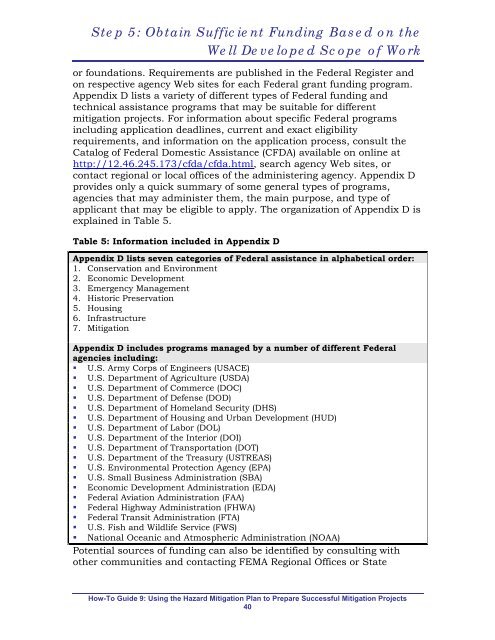Using the Hazard Mitigation Plan to Prepare Successful Mitigation ...
Using the Hazard Mitigation Plan to Prepare Successful Mitigation ...
Using the Hazard Mitigation Plan to Prepare Successful Mitigation ...
You also want an ePaper? Increase the reach of your titles
YUMPU automatically turns print PDFs into web optimized ePapers that Google loves.
Step 5: Obtain Sufficient Funding Based on <strong>the</strong><br />
Well Developed Scope of Work<br />
or foundations. Requirements are published in <strong>the</strong> Federal Register and<br />
on respective agency Web sites for each Federal grant funding program.<br />
Appendix D lists a variety of different types of Federal funding and<br />
technical assistance programs that may be suitable for different<br />
mitigation projects. For information about specific Federal programs<br />
including application deadlines, current and exact eligibility<br />
requirements, and information on <strong>the</strong> application process, consult <strong>the</strong><br />
Catalog of Federal Domestic Assistance (CFDA) available on online at<br />
http://12.46.245.173/cfda/cfda.html, search agency Web sites, or<br />
contact regional or local offices of <strong>the</strong> administering agency. Appendix D<br />
provides only a quick summary of some general types of programs,<br />
agencies that may administer <strong>the</strong>m, <strong>the</strong> main purpose, and type of<br />
applicant that may be eligible <strong>to</strong> apply. The organization of Appendix D is<br />
explained in Table 5.<br />
Table 5: Information included in Appendix D<br />
Appendix D lists seven categories of Federal assistance in alphabetical order:<br />
1. Conservation and Environment<br />
2. Economic Development<br />
3. Emergency Management<br />
4. His<strong>to</strong>ric Preservation<br />
5. Housing<br />
6. Infrastructure<br />
7. <strong>Mitigation</strong><br />
Appendix D includes programs managed by a number of different Federal<br />
agencies including:<br />
• U.S. Army Corps of Engineers (USACE)<br />
• U.S. Department of Agriculture (USDA)<br />
• U.S. Department of Commerce (DOC)<br />
• U.S. Department of Defense (DOD)<br />
• U.S. Department of Homeland Security (DHS)<br />
• U.S. Department of Housing and Urban Development (HUD)<br />
• U.S. Department of Labor (DOL)<br />
• U.S. Department of <strong>the</strong> Interior (DOI)<br />
• U.S. Department of Transportation (DOT)<br />
• U.S. Department of <strong>the</strong> Treasury (USTREAS)<br />
• U.S. Environmental Protection Agency (EPA)<br />
• U.S. Small Business Administration (SBA)<br />
• Economic Development Administration (EDA)<br />
• Federal Aviation Administration (FAA)<br />
• Federal Highway Administration (FHWA)<br />
• Federal Transit Administration (FTA)<br />
• U.S. Fish and Wildlife Service (FWS)<br />
• National Oceanic and Atmospheric Administration (NOAA)<br />
Potential sources of funding can also be identified by consulting with<br />
o<strong>the</strong>r communities and contacting FEMA Regional Offices or State<br />
How-To Guide 9: <strong>Using</strong> <strong>the</strong> <strong>Hazard</strong> <strong>Mitigation</strong> <strong>Plan</strong> <strong>to</strong> <strong>Prepare</strong> <strong>Successful</strong> <strong>Mitigation</strong> Projects<br />
40

















